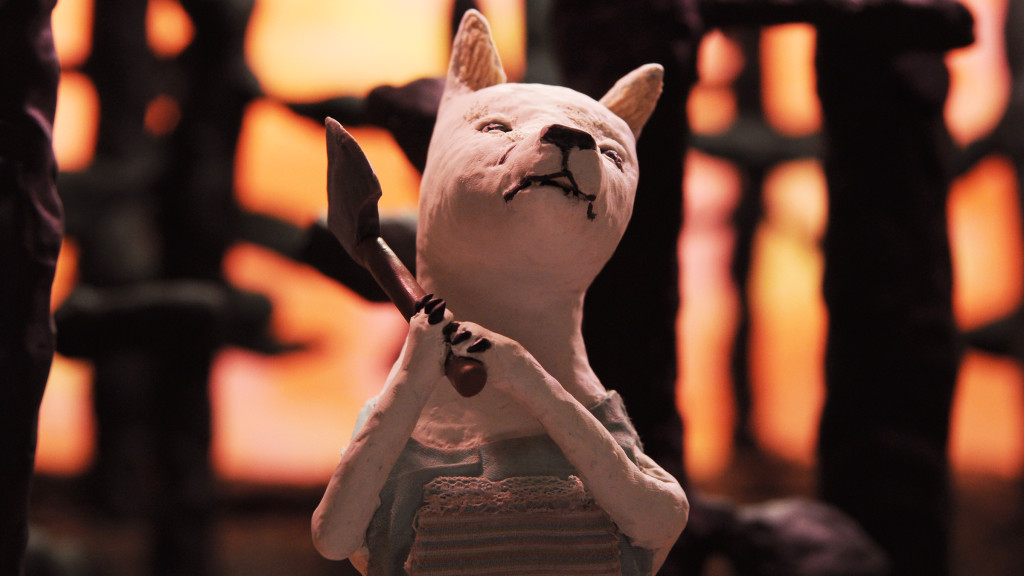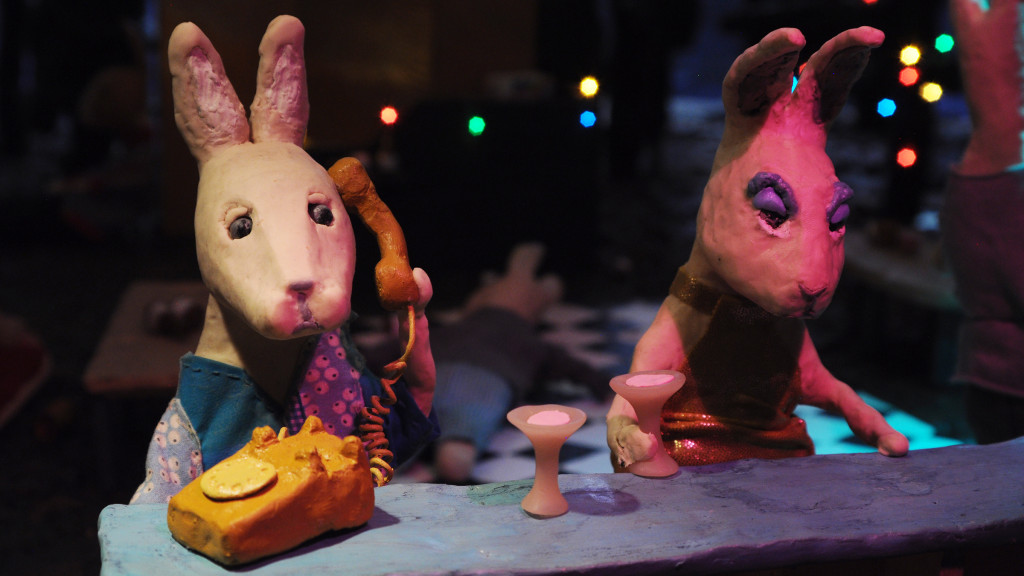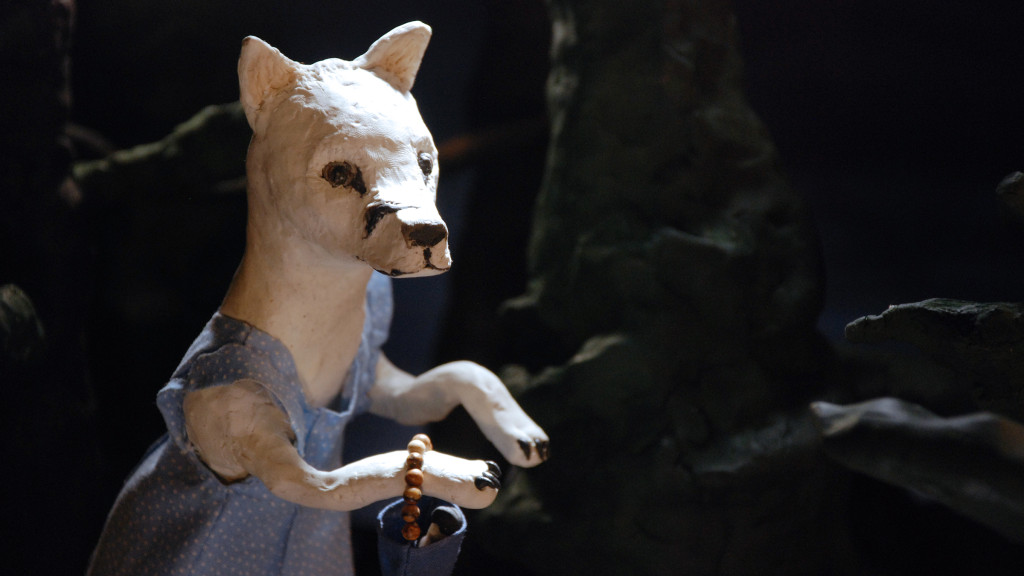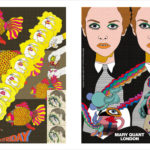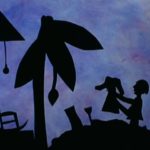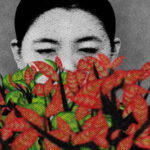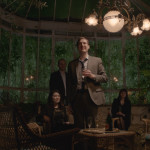Interview: “THE ITCHING”
Dianne Bellino’s THE ITCHING was crowd favourite when it premiered at Montreal’s Fantasia Film Festival earlier this year as part of their “Born of Woman” Program, and as of this writing recently won an award for Best Animation in the Short Film category at Melbourne’s Monster Fest. THE ITCHING combines the insane cuteness of clay animated animals with the revulsion created by a growing price of propecia from canada psychedelic wound.
A female wolf gets an invitation to a forest party being thrown by some wild, coked-out bunnies. Trying her best to dance and schmooze, the wolf’s attempts to socialize become increasingly challenging. It results in an awkward experience when a physical rash she has been hiding progresses to the point where it becomes obvious to the party bunnies; they are aware that something is going on behind her buy levitra in india delicate pinafore dress. Mid-scratch, the bunnies watching and now gathered around her, they perfectly gesture and express with their beautifully crafted clay faces, who invited her?
A first-time dip into the world of clay animation for director Dianne Bellino, who spent seven years making the 15-minute short with animator Adam Davies, THE ITCHING is a tender and fascinating film addressing psychological anxiety.
Esinam Beckley: Why did you decide to use clay animation as a way to tell the story?
Dianne Bellino: When Adam and I were talking about what kind of animation to use, we pretty much latched on to clay animation right from the levitra 20mg side effects beginning. I think one of the reasons was that I had used a little bit of clay animation as had Adam. Neither one of us had huge experience in it. We were just really drawn to the tactile quality of it, the kind of mark making quality of it. We knew from the beginning that we were going to use the animation in a kind of physical expressive way. We knew that we were going to show emotions through the animation. So it seemed like the perfect medium for us. It’s an incredibly painstaking process, and it was just the two of us who made the entire film. So in terms of the armature and everything under the characters we didn’t have professional quality armatures. We built everything. So we learned a lot as we went. If we were to ever make another clay animation I think we’d be able to get it up and running, but so many of the things in the film we had to research and figure out. So it was mostly just a love of handmade stuff even though we are both filmmakers, and even though I’m totally computer savvy, I don’t love working on the computer. So as a filmmaker it was so nice to be able to almost use our hands a lot in an art project type of way.
Adam Davies: Also, we talked about this a lot, where a lot of stop motion uses replacement parts. So before you even shoot they’ll have like 12 different mouth shapes and they replace them in. We wanted more of a visceral quality. We wanted every motion to be unique. We would have to redo takes. We were going for a performance which kind of came out of expressions, and often we didn’t land them. So we would have to redo what we were looking for. We also knew going in, that there wasn’t going to be any dialogue. So, I think we needed it to be more attractive. To grab your attention more than just replacement parts.
DB: Yeah, in terms of all the expressions and what he’s saying about the replacement parts, I’m mostly from a live-action background and you work a lot as a director with actors kind of talking about the interior life of characters. We had a director/animator constant conversation about these characters interior lives and their sort of emotional landscape. Even though there’s no dialogue, and even though some of the characters are these bit parts like the bartender. He’s only in the film twice, but Adam and I have talked about him like we know everything about him. We know what kind of car he drives etc…I think that’s part of what comes through. Even though it was kind of a bummer because it took so long, it allowed us to really know so much about the world.
EB: How did you develop the story?
DB: I was just thinking about this yesterday fairy tales like Little Red Riding Hood. People make of that what they will. There’s many people that write about the interpretations of it, but it’s really up to the person. I feel about the story, even though I wrote it, that I don’t want to take away from what anyone would think of it. I’ve had different audience members say different things. One audience member told me that her daughter had some kind of psychological issue ticking or something and the film reminded her of that. I never want to say oh I wasn’t thinking about that so it’s really open. In terms of developing the story we came up with the idea using animal characters, and as I mentioned during the Q & A the image of the blue moon was an image I had in a dream. Adam and I both just really responded to it as an image of anxiety/body awareness/paranoia. So it started out as just that image. In terms of developing the story, the main thing for me is connection. Wanting to connect with another person, and something inside of you preventing you from doing that. So that’s how I interpreted it. You can see it on a physical level. You can follow the plot, and it’s about a wolf trying to make friends with a clique of bunnies and then sort of through her anxiousness it develops into an infection that she has to deal with. If you think of it metaphorically, I basically wanted to write something about the longing to connect with other people but then how there is something in us that can prevent us from doing that.
EB: What was it like having no experience directing colors, clay etc.…were you easily able to pick up on how everything worked or was it more challenging than that?
DB: That’s a really good question actually because when I say we had experience I mean very little. Adam had done this 30 second thing in college, and I had done this really rudimentary thing for a friend’s band. It wasn’t that much experience, so I think it’s an awesome question. One thing is that Adam had a bunch of experience in stop motion so even though it was stop motion, I think he brought that to the project where he was able to talk a lot about the kind of the gravity, stop-motion, characters, fluidity, that kind of thing. For me as the director, I think that the way I got to relate to it was that we made all the stuff. We designed the characters, made all that stuff, and through the process of making I was very comfortable with the aesthetic. I handmade those animals out of my head, they kind of came to life for us. So I think it was really our luck of having a very organic process. If it was a studio shoot or commercial, and they told me Hey Diane you’re going to direct a Nike commercial that’s in clay animation I might have panicked. I think because of the fact it was an art project, we really could take our time. Adam was saying before about stop motion that they would use glass eyeballs, and I was like I think those are going to look too perfect, maybe I’ll try to actually make eyeballs. We really would have the time organically to assess the material and I feel like that helped me get up to speed. It was also out of order. We would make certain characters and costumes and then we would make other things then take stills. So we just kind of did a lot of research. I see it as research. We were constantly researching as we were doing. The truth is the animating got stronger and stronger. When we started out, it was a little bit more simplistic. By the time we were done what Adam could get out of the tools was really sophisticated.
AD: Yeah, in the beginning we did a lot of research on finding different tones trying to melt them together, and I remember we would do a bunch of different shots, not set up with any backgrounds or anything. Just moving around, and trying to nail different emotions.
DB: Yeah, it was almost like screen tests in live action.
AD: Because neither of us have really worked in clay we had to create a vocabulary to talk about it. We had to figure out a way to be able to bring her live action directing background, bring my stop motion background and come together. It took a lot just to come up with the vocab that took a couple years.
DB: Once we came up with that and made everything, did our screen test, research, got everything going, we got a big grant and then we were able to kind of bang most of it out in two years. Your question is perfect because that was the hardest thing. Not only getting to know clay animation but us bringing our backgrounds together. This is a generalization my aesthetic is a little messier and Adams is a little neater, so it took us awhile to both feel the vibe.
EB: The rash literally takes on a life of its own. It even develops a little ecosystem with tiny fish swimming in the wound. Is there any significance to the changing colours?
DB: I would say there’s two answers but the first answer is (and I know this probably isn’t going to be a satisfying some people) but I’m not the kind of writer where everything has a one-on-one meeting so even though I wrote those fish into it, I never in my head said like fish equal the devil or madness. Some of it is really just from the gut. Just instinctive writing and I think that letting it be instinctive and emotional. Not having it make that much sense. That being said I think you’re phrasing is really apt. It did take on a life of its own. I think a lot of what we talked about was just how to respect the ecosystem. The fish was always in the script but we tried a lot of different variations of what the fish were going to look like exactly so I think that it’s not so much necessarily what they need but it’s keeping the aesthetic and the tone together because the tone is kind of scary kind of funny so when we came up with the fish it was more just like the eyeballs I remember the day we were just like let’s make all the eyeballs a different color. I think I directed from home there’s a tone but I know it goes with everything but I know goes with everything and I try to keep everything together totally rather than a symbolic meaning but overall I think that for me wolf is battling the thing inside her that is keeping her alone and from other people.
EB: The combination of the use of animals, the rash, and the irritation blends seemingly. It is simultaneously adorable, repulsive and mesmerizing. Is this what you were going for?
DB: Not that I’m not interested in content, because I am, and we talked about the content to death, but really the main thing that excites me as a filmmaker is tone. When I feel it come together the different parts when we saw it come together the pinafore dress and the creepy lighting it was like Bang! So, I think the combination of cuteness and scariness feels very familiar. I’m not sure why.
EB: Upon seeing the first imagery, with the description of your film, I thought it was about STDs. I think a couple of other people in the audience made this assumption as well.
Dianne: It’s more of a psychological STD but it can be about anything. For me it was kind of about her insanity, but it can be about anything. Do you know that comic Black Hole?
EB: Yes, I have a copy. The Charles Burns graphic novel with the teenagers that get an STD in the form of mutations. Very disturbing ones. Like the little mouth that grows on that guys neck. I will never get over the neck mouth.
DB: Ha! Yes! It brings up different things when you see it. It’s kind of like things that are somewhat familiar, but really not familiar. I’m also into that. When you recognize certain things, and it kind of grounds you, but then you’re like what the hell is this?
AD: Speaking on that kind of tone feeling vs I’m going to try this this, and this. The film shifted in what it meant for us at different points. I think that really kept it interesting.
DB: The director of static was talking about how her experience with the film keeps changing in time. I find that really lovely about films that are more open. You can come back to it at a different time in your life or a year later. I actually see something different and so does Adam.
AD: Yes, during the making of the film often we would each associate ourselves with either the wolf or a bunny and different scenarios.
EB: How long did it take to finish all the clay animation?
DB: It took 7 years on and off I would say for years gearing up making all this stuff doing all the research raising a little bit of money shooting little then we got a big Grant from the New York State Council on the Arts so we were able to rent a studio in Brooklyn so that was instrumental once we actually had a studio we could set up camp two years filming there. Then after that I did post for about a year. After the six years of working together, I did about a year with music and sound with two artists who live in New York. (Dean Parker and Eli Cohn) They brought so much to it. The music and sound is so right on, and they came in really late. So it’s kind of amazing that they were able both were really able to grasp our world.
EB: You had a black metal sound toward the end of the film. The mix of the dark forest, with creatures, and nature. The black metal really lends itself. How did that happen?
DB: The script actually did say a black metal song would play here, but Dean rendered it, in such an appropriate way. It just gives me the chills. I’ve worked with other music people. Music is really hard for filmmaking. To not have it overwhelm the film but actually go with it. The composer I worked with, he does big movies for a living. Even though I paid him, it was below his rate, and he just really dug in. We had all these long conversations. It really was just a pleasure to work on it, in a film collaboration, and not be under the gun, which I have been in, in the past.
EB: Is this a feminist short? Is there by any chance a significance to the male being a bunny, and the female being a wolf?
DB: I am so happy that you asked that! It’s a really good question…it is 100% is a feminist film, and we’ve never been asked that. I don’t think we’ve ever said that, but we’ve always known that. I also think it’s a feminist film, because it’s about friendship. Even though the Bunny with the mustache in the beginning is trying to come on to the wolf. He just drops out of the story quickly and it really is about this female wolf with all her big emotions. Her internal journey and making a friend. Actually, the bunny she makes friends with is supposed to be a girl. No one knows it’s a girl but us. Even though I’ve never been asked this before now, the fact that she’s a female wolf is really important and absolutely everything we talked about. Good question and yes.
AD: One thing that’s really interesting about the project is that we were more influenced by live-action films. We’d watch The Shining and Repulsion to look at the faces, tone, and emotion. There is one stop motion artist that we really connected with named Natalie Djurberg. Her messiness, and her emotional stuff. Other than that, we didn’t really connect with too much.
DB: I think that’s a really good point I’m not really sure because I haven’t talked to anyone who’s really deep in the animation community to see what they would think of the film most of the people that we talk to are live-action people that really embraced it. I think it’s obvious somehow that it’s made by people that are more from a live action background rather than animation.
EB: It’s interesting when people work in a medium that is not their typical medium. When artists work with tools they don’t know anything about.
DB: Exactly! Because I didn’t know. I see it that way for all art forms, like when people who don’t know how to play music get in bands, that has been some of the coolest stuff.
++++

 December 4, 2016
December 4, 2016  No Comments
No Comments
